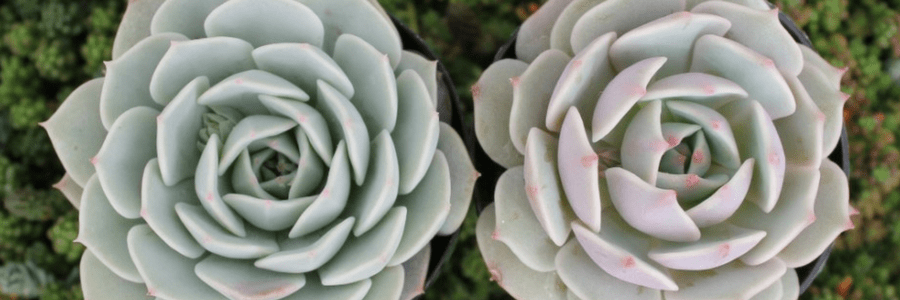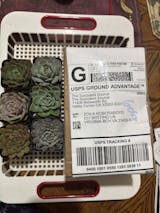Have you heard that succulents are the easiest plants to care for, yet somehow yours keep dying? Never fear—The Succulent Source is here to teach you how to take care of succulents once and for all. Although you do not have to be a master gardener to keep your succulents alive and well, there are a handful common mistakes that people make when caring for a succulent, and we are here to help you set fact from fiction. Avoid any further gardening casualties by diving into our quick, yet comprehensive guide to succulent care.
Clip and Cure
Succulents have the amazing ability to grow from something as small as a leaf. Unlike your typical houseplant, succulents propagate, or grow from an offshoot of the parent plant. Although most succulents can grow from a clean clipping of a leaf, your best chance of growth is when a branch with multiple leaves is clipped.

Once you have your clippings, the next step is let the succulent clippings cure. This is the step that most people skip, leading to waterlogged, rotting succulents. Because succulents are drought tolerant plants, they cannot be oversaturated with water, especially when they are first potted. Avoid this by letting your succulent plant sit in indirect sunlight for three days while drying. This will give the clipping time to callous over so that it does not rot once it is planted. After your clippings have cured, you are ready to move to the potting phase.
Proper Potting
Another major mistake that people make when caring for their succulents is that they do not properly pot them. Unlike many houseplants, succulents do not do well in traditional soil. When shopping for soil, look for one that specifically mentions cacti or succulents. This type of soil will help water drain through so that your succulent does not rot.
If you love DIY projects, try making your own succulent-friendly potting soil at home. Do this by combining one part Perlite, two parts coarse sand, and three parts peat moss. It is important to use coarse sand and not fine sand so that it stays mixed in with the rest of the soil.
After your soil is complete and your cuttings have cured, you want to give your succulents time to form the beginnings of their roots. This process takes around three to four weeks, but will help your succulents in the long run. Do this by placing your clippings in a dry and shaded area. You do not want to put them in direct light where they will get sunburned. Let the succulents sit out for three to four weeks until you see tiny roots forming on the base of your succulent mix clippings. Do not be discouraged if not all of your clippings grow roots. This is common, you can still plant them as the soil may help activate the rooting process.
After this, you are now ready to pot your succulents into the soil. Select a pot or container that has good drainage ability (ideally one with drainage holes so that you do not drown your plants), and pour in your succulent-approved soil. Gently place your clipping into the soil deep enough for it to sit upright, and that is all there is to it!
When to Water
Succulents are widely known for being drought tolerant, so many people wonder, “how often do you water succulents?” The trick is not to over-water these tough guys. The reason that succulents’ claim to fame is that you cannot kill them is because unlike most plants, when you forget to water them for a few weeks they can still thrive.
Unfortunately, there is no magic number or schedule when determining how often you should be watering your succulent. You should check on your succulent once a week, but it is not guaranteed that it will need water every time you check. The key is to only water your succulent when the soil is dry. This will be dependent on the temperature, the amount of water your plant got last time, and the amount of sun it is getting. The rule of thumb is to simply check the soil and only water once it is completely dry.
Soak up some (indirect) Sun
The final element that impacts the success of your succulent plant is the amount of sunlight it gets. Because succulents are both popular indoor and outdoor plants, a common question is, “do succulents need sun?” People often assume since succulents look similar to cacti that they will flourish in desert-like conditions with high temperatures, but not all succulents need direct sunlight. Succulents generally do best with a combination of direct and indirect sunlight, while some types can thrive indoors without ever seeing the sun. It’s very important to monitor their direct sun exposure to avoid baking your succulents. In fact, succulents and their coloring, just like people, can either benefit or be harmed by the sun.

All in all, succulent care is an easy, low-maintenance task. Succulents come in many shapes, colors, textures, and sizes, but you can use the same basic care methods on most varieties. With this guide, you now have all of the information you need to know how to care for your succulents. By following these simple steps, you will have a garden full of happy and healthy plants! And always remember, “Water when dry, and never water if wet!" Over watering is one of the most harmful to your beautiful succulents.



